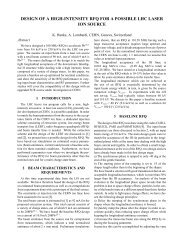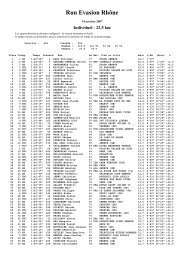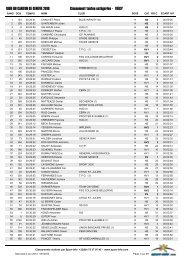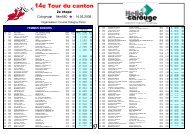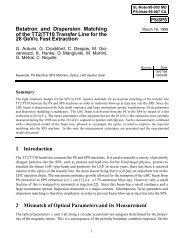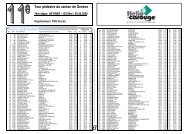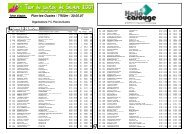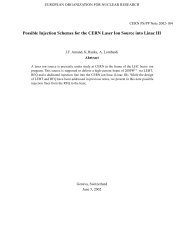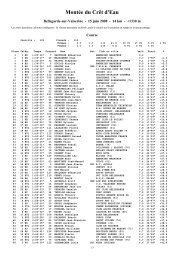conf. proc HPSL2005 - Klaus Hanke's Home Page - CERN
conf. proc HPSL2005 - Klaus Hanke's Home Page - CERN
conf. proc HPSL2005 - Klaus Hanke's Home Page - CERN
- No tags were found...
You also want an ePaper? Increase the reach of your titles
YUMPU automatically turns print PDFs into web optimized ePapers that Google loves.
0/,1%243 561%2743 861%243 9:612743¢¡ £¥¤§¦ ¨© §§! "#"$% &'" &'"(¡*),+-..¨;6
¡N¡N¡¡¡Nraises the shunt impedance and therefore allows to raisethe field gradient while maintaining the same number ofklystrons for the same output energy, c) the higher magneticgradients may allow to use FD focusing instead ofFFDD from the first tank onwards, depending on the PMQtechnology used. This choice would yield a stronger focusingand a smaller beam size. The clear disadvantage isthat PMQs do not allow to change the focusing settings inthe DTL. Nevertheless, in the case of Linac4, this choice isconsidered viable since the whole DTL is only 13 m longand profits from a dedicated matching section at the transitionfrom the MEBT into the DTL. Adapting the elementsof the matching section for different currents, multi particlesimulations (TRACE WIN [10]) <strong>conf</strong>irmed that beam currentsbetween 20 and 60 mA can be matched into a DTLwith PMQs without any degradation in beam quality.synchronous phase & field rampThe previous DTL [8] design employed a phase and field¡ramp in the first #J ¡£¢tank from to and fromoutput emittance [ π mm mrad]0.350.30.250.20.150.1-42/-25 deg-30/-20 degideal0.050.05 0.1 0.15 0.2 0.25 0.3 0.35input emittance [ π mm mrad]Figure 6: Longitudinal rms output emittance versus inputemittance in the DTL.1.5 to 3 MeV, respectively. In the new design the firstdrift tubes are slightly longer in order to reduce the transittime factor. Additionally the starting phase was raisedfrom #J¡ to ¥¤HN . Both measures lower the longitudinalfocusing and thus the field ramp can be eliminatedwithout major changes in the evolution of the longitudinalfocusing. Furthermore the field level was raisedfrom 3 MV/m to 3.5 MV/m, taking advantage of the highershunt impedance due to the smaller drift tubes. Anotheroptimization was done with respect to the maximum synchronousphase in the DTL and throughout Linac4. Thenew design features a maximum synchronous phase of¡£¢ , which slightly raises the accelerationper metre and thus shortens the structure. Thisrise, however, might yield two problems: a) more filamentationand possibly emittance blow-up in longitudinal phasespace, and b) a rise in phase and energy jitter due to statisticalerrors in the RF system. The effect on the emittancewas analysed by simulating the two linac versions: #J a) instead of¡¦¢ to and ¥¤!N b) to with a range of longitudinalemittances § (0.07 MeV to § 0.35 MeVinstead of the nominal value of 0.18 ).Figure 6 shows the output versus input longitudinal emittancefor the two cases. Both versions are close to the theoreticalline, meaning that the different phase settings45have little influence on the longitudinal dynamics. An additionaloutcome of this study was that larger longitudinalinput emittances increase the transverse emittance growth.To test the influence of different synchronous phase settingson the development of phase and energy jitter a simpledrift-kick code was written to evaluate large sets of statisticalerrors [11]. Figure 7 shows the energy jitter evolutionalong the present linac design for an rms error of 0.5 % and . 0.5Due to the frequency jump at 90 MeV at around 40 m theenergy and phase variations double. Using a Gaussian errorFigure 7: Energy jitter in Linac4 for 0.5 % / 0.5 (rms)errors in all RF systems.distribution and 100 different error sets the two settings forthe synchronous phase were simulated. Table 2 shows theresults of these simulations and <strong>conf</strong>irms that the differencebetween the “old” synchronous phase settings and the newone is marginal.Table 2: Energy/phase jitter in Linac4 for 0.5 % 0.5 /(rms) errors in all RF systems.¨©¨“old” Linac4 “new” Linac4¡£¢ ¥¤HN to #Jto612 keV 678 keV8.9 7.3
SUMMARYIn the latest iteration of the Linac4 design severalchanges were implemented: the use of PMQs in the DTL,the field ramp in the first DTL tank was eliminated, raisingthe maximum synchronous phase from -25 to -20 withoutdegrading longitudinal phase space, raising the electricgradient in DTL and CCDTL. All these measures resultedin a length reduction of 3 m (out of 16.4 m) for the DTL,and a reduction of 7 (out of 58 m) for CCDTL and SCL.At the same time the influence of smaller/larger longitudinalinput emittances was tested as well as the effects of RFerrors on the development of phase and energy jitter.[11] M. Pasini, “Phase and amplitude error study for the Linac4RF system”, CARE-HIPPI Document-05-006ACKNOWLEDGMENTSWe want to thank all HIPPI/CARE contributors toLinac4 (CEA/DSM, CNRS/IN2P3, RAL) and all our internationalpartners [CAT, BARC (India), IHEP (China),ITEP, VNIIEF, IHEP, BINP, VNIITF (Russia)] for the technicalprogress in Linac4, especially our colleagues at ITEPMoscow for their contribution to the DTL design.We acknowledge the support of the EuropeanCommunity-Research Infrastructure Activity underthe FP6 “Structuring the European Research Area”program (CARE, Contract No. RII3-CT-2003-506395).REFERENCES[1] K. Hanke et.al., “Superconducting proton linac developmentat <strong>CERN</strong>”, this workshop[2] R. Garoby et.al., “Design of Linac4, a new injector for the<strong>CERN</strong> booster”, in Proceedings of the XXII InternationalLinear Accelerator Conference (2004).[3] M. Vretenar et.al.,“Development of a 352.2 MHz cellcoupleddrift tube linac prototype”, in Proceedings of theXXII International Linear Accelerator Conference (2004).[4] C. Rossi et.al.,“Linac4, a new H ¢ linear injector at <strong>CERN</strong>”,in Proceedings of the XIX Russian Particle AcceleratorConference (2004).[5] F. Gerigk et.al.,“Beam Dynamics for a new 160 MeV ¢ Hlinac at <strong>CERN</strong> (Linac4)”, in Proceedings of the XXII InternationalLinear Accelerator Conference (2004).[6] C. Rossi et.al.,“The SPL front-end: a 3 MeV H ¢ test standat <strong>CERN</strong>”, in Proceedings of the XXII International LinearAccelerator Conference (2004).[7] I. Hofmann, “Stability of anisotropic beams with spacecharge”, Phys.Rev. E 57, 4713 (1998).[8] F. Gerigk and M. Vretenar “Design choices for the SPL normalconducting front-end”, <strong>CERN</strong>-NUFACT-NOTE NF 110(2002).[9] M. Martini, C.R. Prior, “High-intensity and high-densitycharge-exchange injection studies into the <strong>CERN</strong> PS boosterat intermediate energies”, in Proceedings of the IX EuropeanParticle Accelerator Conference (2004).[10] N. Pichoff and D. Uriot, TRACE WIN,DSM/DAPNIA/CEA 2004/45.



